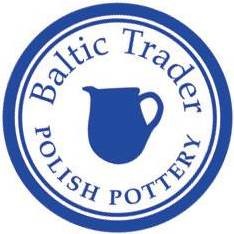Sponge Stamp Decoration
This distinctively styled, 'eye-spot' pottery has been produced in the Lower Silesian town of Boleslawiec (formerly known as Bunzlau) since the 1830's. The pattern on each piece is hand-decorated by a unique 'stempel' (hand stamping) technique using a shaped, sponge stamp. This style of decoration is still known in Germany as 'pfauenauge' (peacock eye).

"Eye-Spot" patterns
One of the most enjoyable features of the Boleslawiec style of ceramics is the huge range of patterns. The best known are the peacock eye patterns which are associated with the German art nouveau (Jugenstil) movement. The picture on the right shows a teapot in the "peacock with leaves" pattern before it is glazed and then fired. The lilac colour changes to cobalt blue in the heat of the kiln.

Freezer, Dishwasher, Microwave, Aga & Ovenproof
We like to describe Boleslawiec stoneware as 'made to be used'. A high (1,230C) kiln temperature and strong, smooth glaze results in a hard wearing finish that is completely impermeable, very durable and cleans easily. No cadmium or lead is used in the glaze. Everything is freezer, dishwasher, microwave, Aga and ovenproof.

Every piece of Boleslawiec Polish pottery is unique and handmade. The strength of the stoneware and high-fired glaze result in a durable, easy-to-clean product that can last for many years.
All our range is hand-finished and imported from Poland and it is not possible for us to stock every item in every pattern - but we do get regular deliveries from the potteries throughout the year. Please note that hand-finishing means that minor variations in patterns are normal.
As with all ceramic products, extreme temperature changes will cause cracking so be careful when transferring dishes from the fridge to a hot oven - or from the oven or microwave to a hard work-surface.
HISTORY
The development of the potters' workshops in the 14th century can be associated with the rich resources of clay in the Boleslawiec region. In 1511 the local potters established their own Guild. Between the 17th and the 19th centuries the main products were hand-rolled pots with white ornamentation (dates and initials were put on the lid). The oldest example of such a pot can be found in the Ceramics Museum and dates from 1749. Apart from pots, they also produced coffee and tea cups, vases, plates, butter dishes and tobacco containers.
By the middle of the 19th century a new way of ornamentation had appeared - the so-called "stamp ornamentation" - and it is preserved to our times. In 1897 the School of Ceramics was founded in Bunzlau. Its headmaster was a technical manager of the Royal Porcelain Manufacture in Berlin, Dr Wilhelm Pukal. The greatest influence of the school can be noticed in Julius Paul's workshop. He produced white pots with stamped and sprayed ornaments.
In 1945, Professor Tadeusz Szafran started to reconstruct the ceramics industry. Next year they started the production, amongst others, at the Paul's workshop. Up to the present day Boleslawiec pottery is in great demand. For over 40 years ceramic workshops have been organised for craftsmen from all over the country. There are several potteries including Zaklady Ceramiczne Boleslawiec, Ceramika Artystyczna, Wiza and Manufaktura Boleslawiec.
Boleslawiec was known as Bunzlau until 1945 when the whole of German Silesia came within the redrawn borders of Poland (as shown below).

